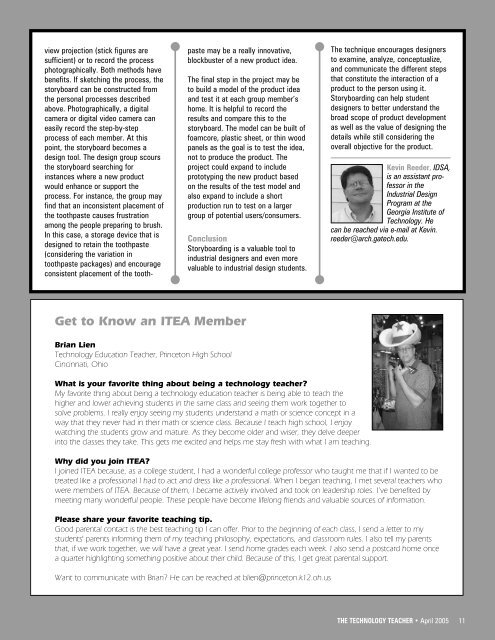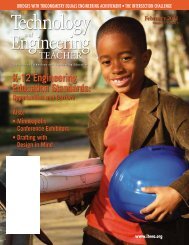Teaching Elements and Principles of Bridge Design - International ...
Teaching Elements and Principles of Bridge Design - International ...
Teaching Elements and Principles of Bridge Design - International ...
Create successful ePaper yourself
Turn your PDF publications into a flip-book with our unique Google optimized e-Paper software.
view projection (stick figures are<br />
sufficient) or to record the process<br />
photographically. Both methods have<br />
benefits. If sketching the process, the<br />
storyboard can be constructed from<br />
the personal processes described<br />
above. Photographically, a digital<br />
camera or digital video camera can<br />
easily record the step-by-step<br />
process <strong>of</strong> each member. At this<br />
point, the storyboard becomes a<br />
design tool. The design group scours<br />
the storyboard searching for<br />
instances where a new product<br />
would enhance or support the<br />
process. For instance, the group may<br />
find that an inconsistent placement <strong>of</strong><br />
the toothpaste causes frustration<br />
among the people preparing to brush.<br />
In this case, a storage device that is<br />
designed to retain the toothpaste<br />
(considering the variation in<br />
toothpaste packages) <strong>and</strong> encourage<br />
consistent placement <strong>of</strong> the toothpaste<br />
may be a really innovative,<br />
blockbuster <strong>of</strong> a new product idea.<br />
The final step in the project may be<br />
to build a model <strong>of</strong> the product idea<br />
<strong>and</strong> test it at each group member’s<br />
home. It is helpful to record the<br />
results <strong>and</strong> compare this to the<br />
storyboard. The model can be built <strong>of</strong><br />
foamcore, plastic sheet, or thin wood<br />
panels as the goal is to test the idea,<br />
not to produce the product. The<br />
project could exp<strong>and</strong> to include<br />
prototyping the new product based<br />
on the results <strong>of</strong> the test model <strong>and</strong><br />
also exp<strong>and</strong> to include a short<br />
production run to test on a larger<br />
group <strong>of</strong> potential users/consumers.<br />
Conclusion<br />
Storyboarding is a valuable tool to<br />
industrial designers <strong>and</strong> even more<br />
valuable to industrial design students.<br />
The technique encourages designers<br />
to examine, analyze, conceptualize,<br />
<strong>and</strong> communicate the different steps<br />
that constitute the interaction <strong>of</strong> a<br />
product to the person using it.<br />
Storyboarding can help student<br />
designers to better underst<strong>and</strong> the<br />
broad scope <strong>of</strong> product development<br />
as well as the value <strong>of</strong> designing the<br />
details while still considering the<br />
overall objective for the product.<br />
Kevin Reeder, IDSA,<br />
is an assistant pr<strong>of</strong>essor<br />
in the<br />
Industrial <strong>Design</strong><br />
Program at the<br />
Georgia Institute <strong>of</strong><br />
Technology. He<br />
can be reached via e-mail at Kevin.<br />
reeder@arch.gatech.edu.<br />
Get to Know an ITEA Member<br />
Brian Lien<br />
Technology Education Teacher, Princeton High School<br />
Cincinnati, Ohio<br />
What is your favorite thing about being a technology teacher?<br />
My favorite thing about being a technology education teacher is being able to teach the<br />
higher <strong>and</strong> lower achieving students in the same class <strong>and</strong> seeing them work together to<br />
solve problems. I really enjoy seeing my students underst<strong>and</strong> a math or science concept in a<br />
way that they never had in their math or science class. Because I teach high school, I enjoy<br />
watching the students grow <strong>and</strong> mature. As they become older <strong>and</strong> wiser, they delve deeper<br />
into the classes they take. This gets me excited <strong>and</strong> helps me stay fresh with what I am teaching.<br />
Why did you join ITEA?<br />
I joined ITEA because, as a college student, I had a wonderful college pr<strong>of</strong>essor who taught me that if I wanted to be<br />
treated like a pr<strong>of</strong>essional I had to act <strong>and</strong> dress like a pr<strong>of</strong>essional. When I began teaching, I met several teachers who<br />
were members <strong>of</strong> ITEA. Because <strong>of</strong> them, I became actively involved <strong>and</strong> took on leadership roles. I’ve benefited by<br />
meeting many wonderful people. These people have become lifelong friends <strong>and</strong> valuable sources <strong>of</strong> information.<br />
Please share your favorite teaching tip.<br />
Good parental contact is the best teaching tip I can <strong>of</strong>fer. Prior to the beginning <strong>of</strong> each class, I send a letter to my<br />
students' parents informing them <strong>of</strong> my teaching philosophy, expectations, <strong>and</strong> classroom rules. I also tell my parents<br />
that, if we work together, we will have a great year. I send home grades each week. I also send a postcard home once<br />
a quarter highlighting something positive about their child. Because <strong>of</strong> this, I get great parental support.<br />
Want to communicate with Brian? He can be reached at blien@princeton.k12.oh.us<br />
THE TECHNOLOGY TEACHER • April 2005 11
















